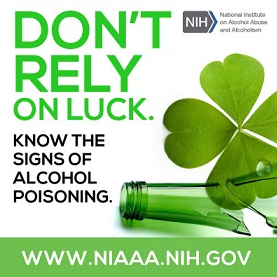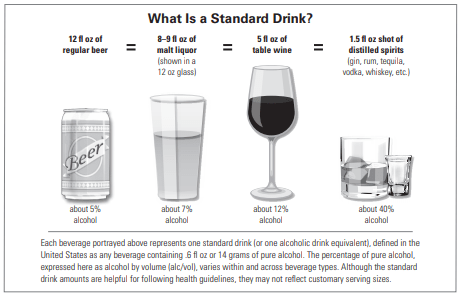
It’s a dangerous time of year with St. Patrick’s Day and the apparent need to binge drink massive quantities of green beer, Guinness and/or various whisky based drinks. Also, many bars are reopening and people who have been denied the pleasures of drinking in public for the last year due to Covid-19 restrictions might feel they have a lot of time to make up for by overindulging or failing to realize they’ve lost some of their capacity to drink booze.
It’s also particularly dangerous for LGBTQ drinkers…the gay community has a long history of having issues with alcohol abuse and it’s important to know not only HOW to drink but also how to watch out for each other when others over indulge and it leads to serious physical consequences.
Fortunately, the National Institute on Alcohol Abuse and Alcoholism has issued handy guidelines on how to avoid bad situations and how to recognize the danger signs of alcohol poisoning.
Drinking too much and too quickly can lead to significant impairments in motor coordination, decision-making, impulse control, and other functions, increasing the risk of harm. Continuing to drink despite clear signs of significant impairments can result in an alcohol overdose.
What Is an Alcohol Overdose?
An alcohol overdose occurs when there is so much alcohol in the bloodstream that areas of the brain controlling basic life-support functions—such as breathing, heart rate, and temperature control—begin to shut down. Symptoms of alcohol overdose include mental confusion, difficulty remaining conscious, vomiting, seizure, trouble breathing, slow heart rate, clammy skin, dulled responses such as no gag reflex (which prevents choking), and extremely low body temperature. Alcohol overdose can lead to permanent brain damage or death.
What tips the balance from drinking that produces impairment to drinking that puts one’s life in jeopardy varies among individuals. Age, sensitivity to alcohol (tolerance), gender, speed of drinking, medications you are taking, and amount of food eaten can all be factors.
Alcohol use and taking opioids or sedative-hypnotics, such as sleep and anti-anxiety medications, can increase your risk of an overdose. Examples of these medications include sleep aids such as zolpidem and eszopiclone, and benzodiazepines such as diazepam and alprazolam. Even drinking alcohol while taking over-the-counter antihistamines can be dangerous. Using alcohol with opioid pain relievers such as oxycodone and morphine or illicit opioids such as heroin is also a very dangerous combination. Like alcohol, these drugs suppress areas in the brain that control vital functions such as breathing. Ingesting alcohol and other drugs together intensifies their individual effects and could produce an overdose with even moderate amounts of alcohol.

As BAC Increases—So Do the Risks
As blood alcohol concentration (BAC) increases, so does the effect of alcohol—as well as the risk of harm. Even small increases in BAC can decrease motor coordination, make a person feel sick, and cloud judgment. This can increase an individual’s risk of being injured from falls or car crashes, experiencing acts of violence, and engaging in unprotected or unintended sex. When BAC reaches high levels, amnesia (blackouts), loss of consciousness (passing out), and death can occur.
BAC can continue to rise even when a person stops drinking or is unconscious. Alcohol in the stomach and intestine continues to enter the bloodstream and circulate throughout the body.
It is dangerous to assume that an unconscious person will be fine by sleeping it off. One potential danger of alcohol overdose is choking on one’s own vomit. Alcohol at very high levels can hinder signals in the brain that control automatic responses such as the gag reflex. With no gag reflex, a person who drinks to the point of passing out is in danger of choking on his or her vomit and dying from a lack of oxygen (i.e., asphyxiation). Even if the person survives, an alcohol overdose like this can lead to long-lasting brain damage.
Critical Signs and Symptoms of an Alcohol Overdose
- Mental confusion, stupor
- Difficulty remaining conscious, or inability to wake up
- Vomiting
- Seizures
- Slow breathing (fewer than 8 breaths per minute)
- Irregular breathing (10 seconds or more between breaths)
- Slow heart rate
- Clammy skin
- Dulled responses, such as no gag reflex (which prevents choking)
- Extremely low body temperature, bluish skin color, or paleness
Know the Danger Signs and Act Quickly
Know the danger signals and, if you suspect that someone has an alcohol overdose, call 911 for help immediately. Do not wait for the person to have all the symptoms, and be aware that a person who has passed out can die. Don’t play doctor—cold showers, hot coffee, and walking do not reverse the effects of alcohol overdose and could actually make things worse.
While waiting for medical help to arrive:
- Be prepared to provide information to the responders, including the type and amount of alcohol the person drank; other drugs he or she took, if known; and any health information that you know about the person, such as medications currently taking, allergies to medications, and any existing health conditions.
- Do not leave an intoxicated person alone, as he or she is at risk of getting injured from falling or choking. Keep the person on the ground in a sitting or partially upright position rather than in a chair.
- Help a person who is vomiting. Have him or her lean forward to prevent choking. If a person is unconscious or lying down, roll him or her onto one side with an ear toward the ground to prevent choking.
Stay alert to keep your friends and family safe. And remember—you can avoid the risk of an alcohol overdose by drinking responsibly if you choose to drink, or by not drinking at all.










